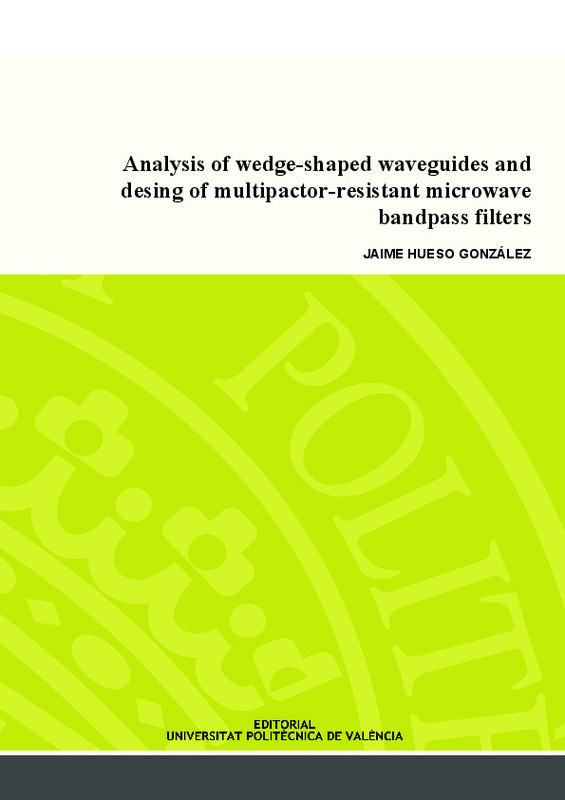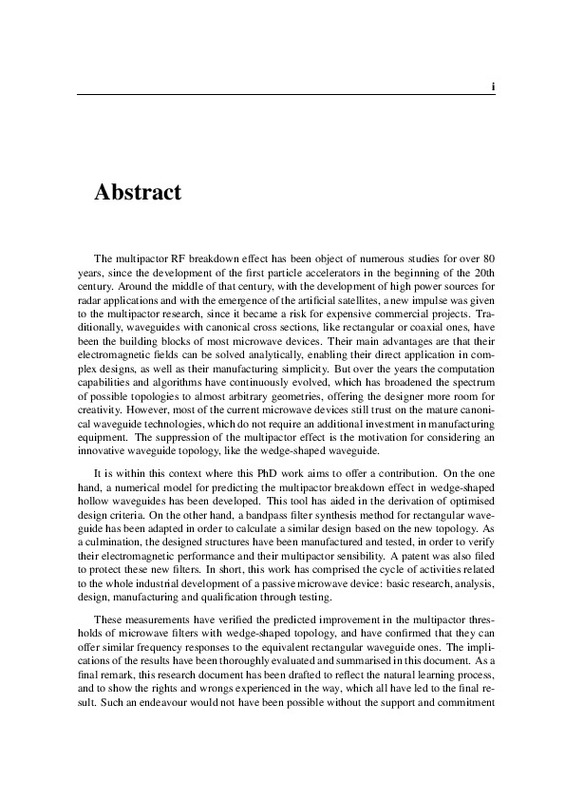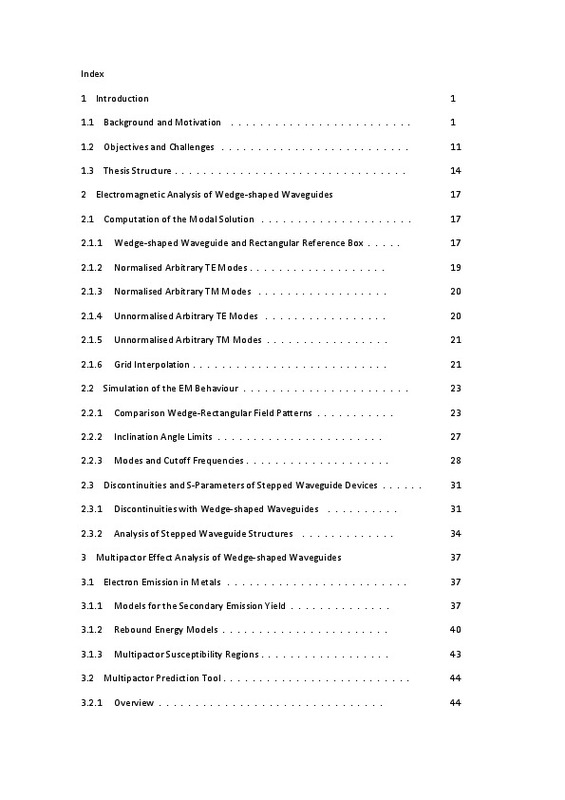- RiuNet repositorio UPV
- :
- Investigación
- :
- Tesis doctorales
- :
- Ver ítem
JavaScript is disabled for your browser. Some features of this site may not work without it.
Buscar en RiuNet
Listar
Mi cuenta
Estadísticas
Ayuda RiuNet
Admin. UPV
Analysis of wedge-shaped waveguides and design of multipactor-resistant microwave bandpass filters. Análisis de guías de onda en forma de cuña y diseño de filtros de microondas paso-banda resistentes al efecto multipactor
Mostrar el registro sencillo del ítem
Ficheros en el ítem
| dc.contributor.advisor | Boria Esbert, Vicente Enrique
|
es_ES |
| dc.contributor.advisor | Gimeno Martinez, Benito
|
es_ES |
| dc.contributor.author | Hueso González, Jaime
|
es_ES |
| dc.date.accessioned | 2013-11-19T13:35:34Z | |
| dc.date.available | 2013-11-19T13:35:34Z | |
| dc.date.created | 2013-10-29T11:00:13Z | es_ES |
| dc.date.issued | 2013-11-19T13:35:31Z | es_ES |
| dc.identifier.isbn | 978-84-9048-066-3 | es_ES |
| dc.identifier.uri | http://hdl.handle.net/10251/33750 | |
| dc.description.abstract | El efecto multipactor de ruptura en RF ha sido objeto de numerosos estudios desde hace más de 80 años, a partir del desarrollo de los primeros aceleradores de partículas en la primera mitad del siglo XX. A mediados de ese siglo, con el desarrollo de fuentes de alta potencia para aplicaciones radar y la llegada de los satélites artificiales, la investigación del multipactor cobró una considerable relevancia, al convertirse este fenómeno en un riesgo determinante para costosos proyectos comerciales. Las guías de onda con secciones rectas canónicas, como las rectangulares o las coaxiales, han sido tradicionalmente las más utilizadas en dispositivos de microondas. Sus principales ventajas son que sus campos electromagnéticos pueden resolverse analíticamente, lo que permite su aplicación directa en diseños complejos, y la simplicidad de su fabricación. Pero las capacidades de computación y las prestaciones de los algoritmos se han multiplicado con los años, lo que ha permitido ampliar el espectro de posibles topologías a geometrías casi arbitrarias, ofreciendo al diseñador una mayor libertad creativa. En todo caso, gran parte de los dispositivos de microondas actuales siguen confiando en la madurez y fiabilidad de las tecnologías de guía de onda tradicionales, que no requieren una inversión adicional en equipos de fabricación. La supresión del efecto multipactor es la motivación para arriesgarse a probar topologías de guía de onda innovadoras, como la guía en forma de cuña. Es en este contexto donde este trabajo de doctorado pretende ofrecer una contribuci'on. En primer lugar, se ha desarrollado un modelo numérico para predecir el efecto multipactor de ruptura en guías de onda huecas en forma de cuña. Esta herramienta ha permitido la identificación de criterios óptimos de diseño. Así mismo, se ha adaptado un método de síntesis de filtros paso-banda en guía rectangular para poder realizar un diseño similar pero basado en la nueva topología. Como culminación, las estructuras diseñadas se han fabricado y medido, con el fin de comprobar sus prestaciones electromagnéticas y su sensibilidad al efecto multipactor. Se ha registrado además una patente para proteger estos nuevos filtros. En resumen, el trabajo ha abarcado el ciclo de actividades relacionadas con el desarrollo industrial completo de un dispositivo pasivo de microondas: investigación básica, análisis, diseño, fabricación y calificación con medidas en el laboratorio. Estas medidas han comprobado la mejora prevista en los umbrales de multipactor de los filtros de microondas con topología en forma de cu¿na, y han confirmado que pueden ofrecer respuestas en frecuencia similares a aquellas de filtros basados en una guía de onda rectangular equivalente. Las implicaciones de los resultados han sido evaluadas a fondo y resumidas en este documento. Como observación final, se ha intentado redactar esta investigación de manera que refleje el proceso natural de aprendizaje, mostrando los aciertos y errores experimentados en el camino, todos los cuales han conducido al resultado final. Este reto no hubiera sido posible sin el apoyo y compromiso de varios profesionales de diferentes centros de investigación e industrias europeas (Universidad Politécnica de Valencia, Universidad de Valencia, Agencia Espacial Europea, Thales Alenia Espacio Espa¿na, Technische Universit¿at Darmstadt, 'Ecole Polythecnique F'ed'erale de Lausanne, Tesat, Aurora Software and Testing y Val Space Consortium), a los cuales estoy agradecido. | es_ES |
| dc.description.abstract | The multipactor RF breakdown effect has been object of numerous studies for over 80 years, since the development of the first particle accelerators in the beginning of the 20th century. Around the middle of that century, with the development of high power sources for radar applications and with the emergence of the artificial satellites, a new impulse was given to the multipactor research, since it became a risk for expensive commercial projects. Traditionally, waveguides with canonical cross sections, like rectangular or coaxial ones, have been the building blocks of most microwave devices. Their main advantages are that their electromagnetic fields can be solved analytically, enabling their direct application in complex designs, as well as their manufacturing simplicity. But over the years the computation capabilities and algorithms have continuously evolved, which has broadened the spectrum of possible topologies to almost arbitrary geometries, offering the designer more room for creativity. However, most of the current microwave devices still trust on the mature canonical waveguide technologies, which do not require an additional investment in manufacturing equipment. The suppression of the multipactor effect is the motivation for considering an innovative waveguide topology, like the wedge-shaped waveguide. It is within this context where this PhD work aims to offer a contribution. On the one hand, a numerical model for predicting the multipactor breakdown effect in wedge-shaped hollow waveguides has been developed. This tool has aided in the derivation of optimised design criteria. On the other hand, a bandpass filter synthesis method for rectangular waveguide has been adapted in order to calculate a similar design based on the new topology. As a culmination, the designed structures have been manufactured and tested, in order to verify their electromagnetic performance and their multipactor sensibility. A patent was also filed to protect these new filters. In short, this work has comprised the cycle of activities related to the whole industrial development of a passive microwave device: basic research, analysis, design, manufacturing and qualification through testing. These measurements have verified the predicted improvement in the multipactor thresholds of microwave filters with wedge-shaped topology, and have confirmed that they can offer similar frequency responses to the equivalent rectangular waveguide ones. The implications of the results have been thoroughly evaluated and summarised in this document. As a final remark, this research document has been drafted to reflect the natural learning process, and to show the rights and wrongs experienced in the way, which all have led to the final result. Such an endeavour would not have been possible without the support and commitment of several professionals from different European research centres and industries (Universidad Polit'ecnica de Valencia, Universidad de Valencia, European Space Agency, Thales Alenia Espacio Spain, Technische Universit¿at Darmstadt, 'Ecole Polythecnique F'ed'erale de Lausanne, Tesat, Aurora Software and Testing and Val Space Consortium), for which I am grateful. | en_EN |
| dc.language | Inglés | es_ES |
| dc.publisher | Editorial Universitat Politècnica de València | es_ES |
| dc.rights | Reserva de todos los derechos | es_ES |
| dc.source | Riunet | es_ES |
| dc.subject | Bandpass filters | es_ES |
| dc.subject | Circuit synthesis | es_ES |
| dc.subject | Microwave filters | es_ES |
| dc.subject | Multipactor | es_ES |
| dc.subject | Space technology | es_ES |
| dc.subject | Vacuum breakdown | es_ES |
| dc.subject | Wedge-shaped waveguide | es_ES |
| dc.subject | High-power testing | es_ES |
| dc.subject | Effective electron | es_ES |
| dc.subject | Secondary emission | es_ES |
| dc.subject | Threshold prediction | es_ES |
| dc.subject.classification | TEORIA DE LA SEÑAL Y COMUNICACIONES | es_ES |
| dc.title | Analysis of wedge-shaped waveguides and design of multipactor-resistant microwave bandpass filters. Análisis de guías de onda en forma de cuña y diseño de filtros de microondas paso-banda resistentes al efecto multipactor | |
| dc.type | Tesis doctoral | es_ES |
| dc.identifier.doi | 10.4995/Thesis/10251/33750 | es_ES |
| dc.rights.accessRights | Abierto | es_ES |
| dc.contributor.affiliation | Universitat Politècnica de València. Departamento de Comunicaciones - Departament de Comunicacions | es_ES |
| dc.description.bibliographicCitation | Hueso González, J. (2013). Analysis of wedge-shaped waveguides and design of multipactor-resistant microwave bandpass filters. Análisis de guías de onda en forma de cuña y diseño de filtros de microondas paso-banda resistentes al efecto multipactor [Tesis doctoral]. Editorial Universitat Politècnica de València. https://doi.org/10.4995/Thesis/10251/33750 | es_ES |
| dc.description.accrualMethod | TESIS | es_ES |
| dc.type.version | info:eu-repo/semantics/acceptedVersion | es_ES |
| dc.relation.tesis | 7069 | es_ES |
Este ítem aparece en la(s) siguiente(s) colección(ones)
-
Tesis doctorales [5389]
-
Tesis. Editorial UPV [172]












